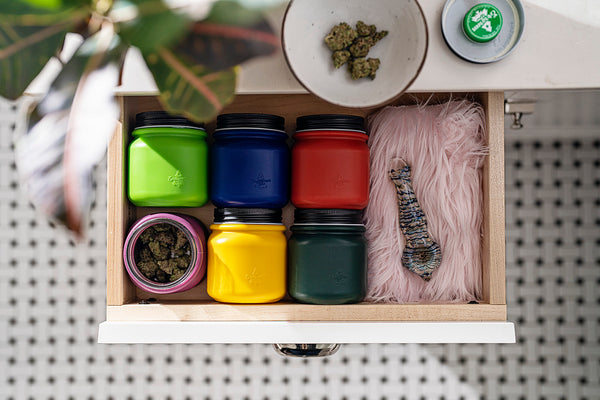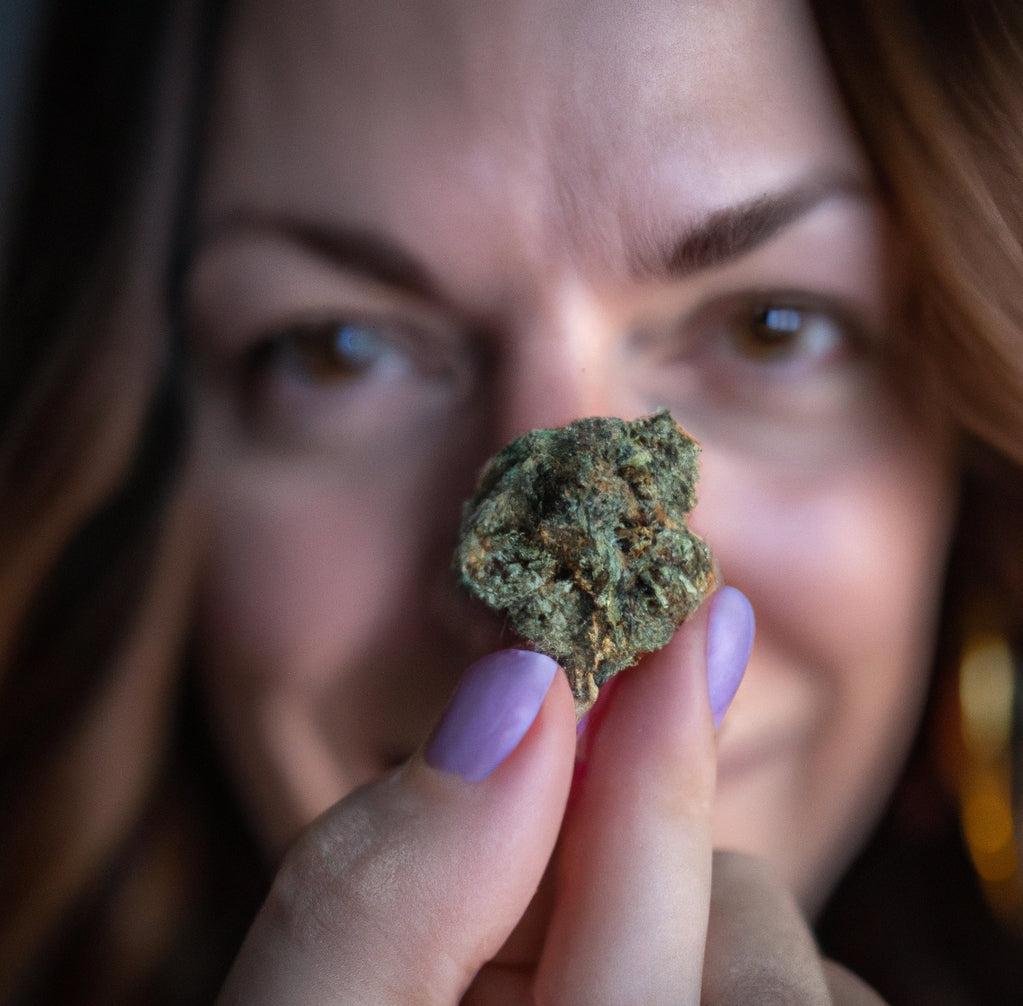Concerned there is mold on weed you've had in storage? While it may be easy to determine if old bread or cheese is moldy, mold on weed isn’t always as easy to spot. Mold can make its way into the tightly clustered flower buds, which can make the problem difficult to diagnose.
Smoking moldy weed can result in undesirable outcomes, including negative health impacts, unpleasant taste, and decreased potency. However, mold growth on weed can be prevented, and weed can be kept fresh for extended periods. The following information explains the risks of mold on marijuana, how to identify moldy weed, and how to prevent mold growth.
Avoid Mold With Humidity-Controlled Stash Jars
The Dangers of Smoking Moldy Weed
Commercially produced cannabis is tested for mold at the state level, with many states having very stringent requirements, but homegrown bud or even commercial weed that has been around for a while can develop mold if not stored properly.
Can you smoke moldy weed? Short answer: it is definitely not recommended. If it happens by accident, you will most likely be fine. You’ll likely never notice anything drastic - it’s typically more of an unpleasant experience than a dangerous one. You will notice the bud tastes "off" or musty, it may have an unusual odor, and the effects also will likely not be what you would expect. Nevertheless, smoking mold is not a great idea because there is always a potential that you could experience ill effects due to the present mold spores.
Smoking moldy weed can lead to:
- Coughing
- Vomiting
- Nausea
If you are allergic to mold (a relatively common allergy), smoking moldy weed can cause inflammation of your respiratory system, particularly your sinuses and lungs. This can result in asthma, congestion, and sinus pain. In addition, someone who suffers from a severe mold allergy could experience even more serious effects, although it is a rare event.
Certain fungi can be especially dangerous. In a UC Davis Study, researchers examined fungus on weed samples purchased from legal cannabis dispensaries. They discovered Cryptococcus, Mucor, and Aspergillus – fungi linked to lung infections in people with weakened immune systems. Aspergillosis can be a major concern with mold on weed, as this type of mold can cause a severe lung infection that causes chest pain, bloody sputum, difficulty breathing, and fever.
What does moldy weed look like?

For the most part, mold on weed will show up as a grayish or whitish, often webby coating (but the exact colors of the mold can vary). The mold will likely be coating outside areas of the bud, but it can also be deeper within the flowers where it is almost impossible to spot with the naked eye.
Trust your nose when looking for mold on weed. Moldy weed usually takes on aromatics not common to the cannabis plant, smelling mildewy or even a little like old hay. If you've done what you can to keep weed fresh, but you still catch an odd odor when you take a whiff, it could mean your storage measures were not enough to stop weed mold from growing.
Moldy Weed vs Trichomes
Trichomes are shiny, sticky crystals that form on cannabis flower. Trichomes look almost like sparkling glitter. By contrast, mold will take on different appearances depending on the type. You may see spots that look powdery and white, gray and fluffy, or even black.
What does mold on weed taste like?
If you light up and your weed has an "off" taste, it is best to pay attention. Moldy weed can taste a lot like what you would expect: like you've inhaled a mouth full of mildew. You may still recognize the slight taste of terpenes depending on the extent of the mold, but those enjoyable flavors will definitely be overpowered by the dank taste of mold.
The Effects of Moldy Weed - Does It Still Have Psychoactive Effects?
When it comes to the effects of moldy weed, one might wonder if it still retains its psychoactive properties. Unfortunately, mold can significantly impact the psychoactive effects of cannabis. Mold spores and fungi that grow on cannabis can consume the plant's cannabinoids, including THC, which is the primary psychoactive component.
This degradation means that even if you decide to smoke or vape moldy weed, you might not experience the high you're expecting. Instead, you could be left with a diminished or altered effect, where the psychoactive potency is notably reduced. While moldy weed might still contain some THC, the quality and intensity of the psychoactive experience is usually compromised. This, paired with the fact that mold has the potential to make you sick, means it is usually best to avoid consuming it if you have any suspicions at all.
How to Fix Moldy Bud
Unfortunately, once you've got mold on weed, there's not a lot you can do. Some people will trim away what appears to be moldy and then smoke or vape what's left, but even this is questionable. Mold spores can be microscopic, and when you're dealing with tightly bundled clusters of flower, it can be really hard to tell where there is mold and where there is no mold. Therefore, when in doubt, throw it out just to be safe, even if that means you have to take a loss.
How to Prevent Mold on Marijuana

Proper storage is the key to keeping mold away from your weed. Mold spores are a natural part of the environment, but they gravitate to organic materials where certain environmental conditions are met, and the spores will be most likely capable of growing and thriving. To prevent mold on weed, you will need to control everything from temperature to oxygen exposure and humidity in the storage container. Here are a few tips to keep weed fresh and and how to stop moldy weed.
Avoid hot or frigid temps
Certain temperatures are more conducive to mold growth. The best temperature range for weed storage is above 50°F (10°C) and under 77°F (25°C). Avoid storing your weed in the fridge or freezer, as this can damage the trichomes and cause condensation, creating a mold-friendly environment. To prevent mold, keep your weed stored at a consistent temperature and avoid drastic temperature changes.
Watch the humidity levels
To prevent mold from growing, the level of moisture in your cannabis has to be controlled. Shoot for humidity levels between 55 and 65 percent - above that range, conditions become more favorable for mold growth, while below that range, cannabis can become dry and crumbly. Maintain the appropriate level with a humidity control device. For example, Evergreen two-way humidification pods will help maintain a stable humidity level inside your stash jar.
Use the right storage container
When you intend to store weed long-term, make sure you are using a container built for the purpose. A glass jar is best, but look for a jar that has an airtight lid, something to keep out the light, and can accept some level of humidity control. Our Evergreen Storage Solution contains a glass jar with a silicone sleeve and a humidity control pod to prevent mold and keep your weed fresh. This combination can mean the best chance of keeping your weed fresh for the long term, but also to help thwart issues that could arise with mold.
Well-Stored Weed Means Long-Term Quality
Under the right storage conditions, weed can last a really long time without you having to worry about mold or the effects that it can have on your weed or your health if accidentally consumed. By controlling humidity, temperature, and light exposure, you not only prevent mold but also maintain the potency and flavor of your cannabis. Proper storage ensures that your weed remains a safe and enjoyable experience. Be sure to check out our full guide on storing cannabis for more detailed advice on preserving your stash and how to stop weed mold.
.


